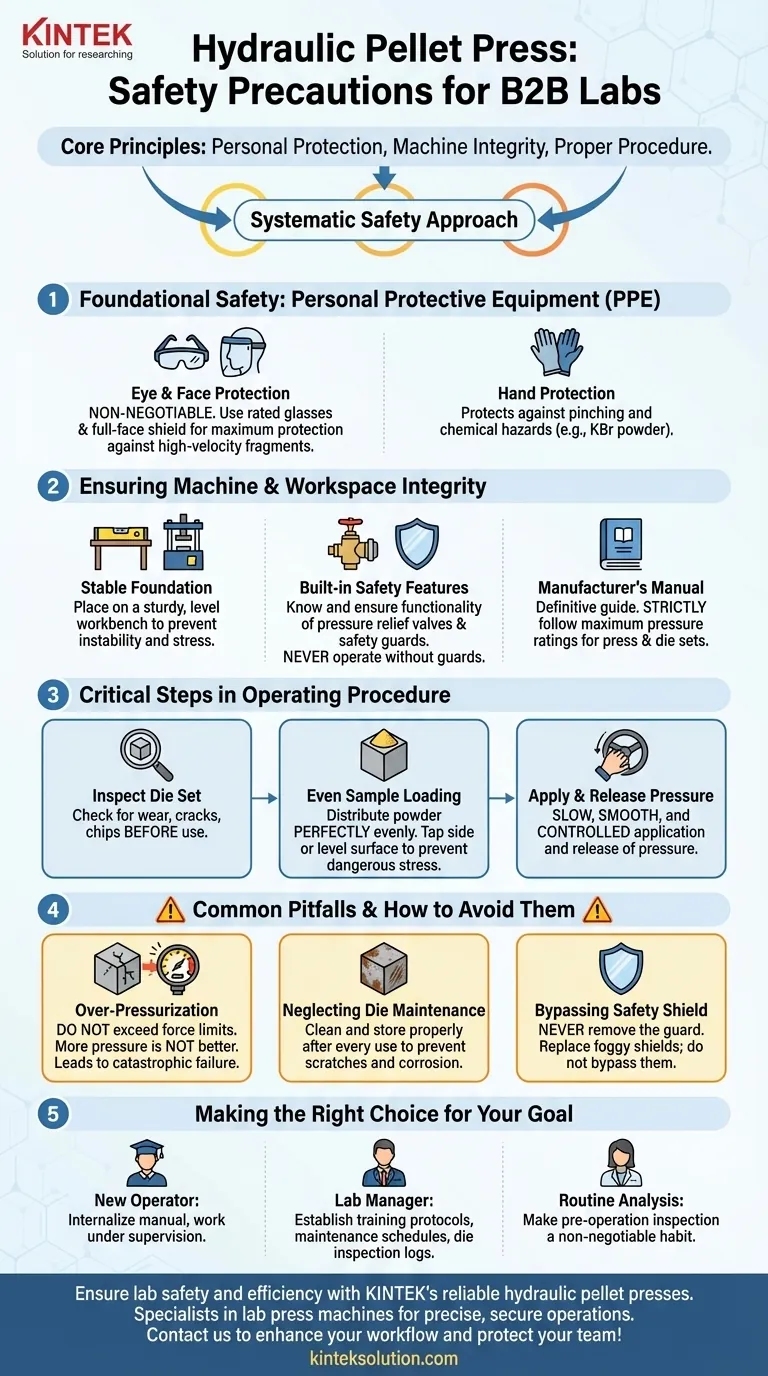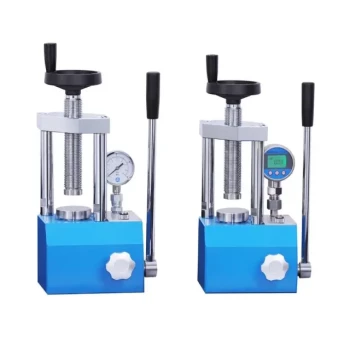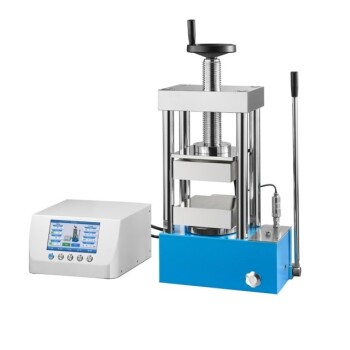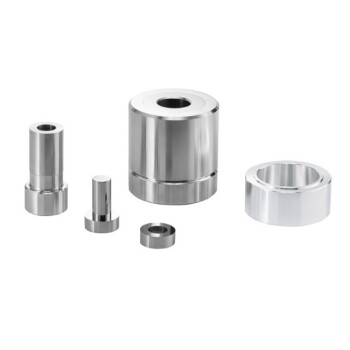At its core, operating a hydraulic pellet press safely requires a systematic approach that addresses personal protection, machine integrity, and proper procedure. You must wear appropriate Personal Protective Equipment (PPE) like safety glasses and gloves, ensure the press is on a stable, level surface, and meticulously follow the manufacturer's guidelines for pressure limits and operation.
The immense force generated by a hydraulic press is its greatest asset and its primary hazard. True safety is not about a single checklist, but about understanding that the operator, the procedure, and the machine itself are all interconnected parts of a single safety system.

Foundational Safety: Personal Protective Equipment (PPE)
Your first line of defense is always the equipment you wear. The high pressures involved mean that failures, while rare, can be energetic and dangerous.
Eye and Face Protection
Safety glasses are non-negotiable. A catastrophic failure of the die set under pressure can result in metal fragments being ejected at high velocity. Standard prescription glasses are not a substitute for rated safety glasses or goggles.
For maximum protection, a full-face shield used in conjunction with safety glasses is the best practice.
Hand Protection
Gloves serve two purposes. They protect your hands from being pinched by moving parts and provide a barrier when handling chemical powders, such as the potassium bromide (KBr) commonly used in spectroscopy sample preparation.
Ensuring Machine and Workspace Integrity
The press itself and its environment are critical components of the safety system. An improperly set up or maintained machine is a significant liability.
A Stable Foundation
The hydraulic press must be placed on a sturdy, level workbench capable of supporting its weight without any wobble or vibration, especially while under load. Any instability can lead to misalignment and dangerous stress on the equipment.
Understanding Built-in Safety Features
Modern presses are equipped with features designed to prevent the most common failure modes. You must know what they are and ensure they are functional.
Key features include pressure relief valves, which prevent the system from being pressurized beyond its design limits, and polycarbonate safety guards or shields, which contain any potential projectiles in the event of a die failure. Never operate a press with these guards removed or disabled.
The Manufacturer's Manual is Your Guide
The instructions provided by the manufacturer are the definitive guide to your specific model's capabilities and limitations. These documents contain critical information on maximum pressure ratings for both the press and the die sets. Exceeding these limits is the most common cause of accidents.
Critical Steps in the Operating Procedure
How you perform the task is just as important as your protective gear. Each step in preparing and pressing a pellet has safety implications.
Inspecting the Die Set
Before every use, carefully inspect the die set (the anvil and plunger) for any signs of wear, hairline cracks, or chips. A compromised die is exponentially more likely to fail under pressure.
The Importance of Even Sample Loading
When loading your sample powder into the die cavity, it must be distributed perfectly evenly. Uneven loading creates unbalanced forces and immense stress concentrations when pressure is applied.
This imbalance is a leading cause of shattered dies. Gently tapping the side of the die or using a tool to level the powder surface is a crucial safety step.
Applying and Releasing Pressure
Pressure should always be applied in a slow, smooth, and controlled manner. Abruptly applying force can shock the system. Likewise, when the pellet is formed, release the pressure gradually to allow the components to decompress safely.
Common Pitfalls and How to Avoid Them
Understanding common mistakes is key to preventing them. The immense stored energy in a pressurized system demands respect.
The Danger of Over-Pressurization
Never assume "more pressure is better." Each die set has a specific force limit that must not be exceeded. Trying to create a "perfect" pellet by exceeding this limit is the single most dangerous action an operator can take. This is what the pressure relief valve is designed to prevent, but you should not rely on it as part of your standard procedure.
Neglecting Die Maintenance
Over time, the polished surfaces of a die can become scratched or worn. These imperfections create stress points that can become the origin of a catastrophic failure. Clean your die set after every use and store it properly to prevent corrosion or damage.
Bypassing the Safety Shield
It can be tempting to remove the safety guard for a clearer view of the die. This should never be done. The shield is your only physical barrier if the die shatters. A foggy or scratched shield should be replaced, not removed.
Making the Right Choice for Your Goal
Your approach to safety should align with your role and experience level.
- If you are a new operator: Your primary focus is to internalize the manufacturer's manual and always work under the supervision of an experienced user until you are fully confident.
- If you are managing a lab: Your priority is to establish a mandatory training protocol, a regular maintenance schedule for the press, and a logbook for inspecting die sets.
- If you are performing routine analysis: Make the pre-operation inspection of the press and die set a non-negotiable habit that becomes second nature.
Ultimately, consistent, proactive safety practices transform the hydraulic press from a potential hazard into a powerful and reliable tool.
Summary Table:
| Safety Category | Key Precautions |
|---|---|
| Personal Protection | Wear safety glasses, gloves, and face shields; avoid bypassing guards. |
| Machine Setup | Place on stable, level surface; check pressure relief valves and safety shields. |
| Operating Procedure | Follow manufacturer guidelines; inspect dies; load samples evenly; apply pressure slowly. |
| Common Pitfalls | Avoid over-pressurization; maintain dies; never remove safety shields. |
Ensure your lab's safety and efficiency with KINTEK's reliable hydraulic pellet presses. As specialists in lab press machines, including automatic, isostatic, and heated models, we provide equipment designed for precise, secure operations in laboratory settings. Contact us today to learn how our solutions can enhance your workflow and protect your team!
Visual Guide

Related Products
- Automatic Laboratory Hydraulic Press Lab Pellet Press Machine
- Manual Laboratory Hydraulic Pellet Press Lab Hydraulic Press
- Manual Laboratory Hydraulic Press Lab Pellet Press
- Laboratory Hydraulic Press Lab Pellet Press Button Battery Press
- Laboratory Hydraulic Press Lab Pellet Press Machine for Glove Box
People Also Ask
- What is the purpose of creating pellets for XRF spectroscopy using a hydraulic press? Ensure Accurate and Repeatable Elemental Analysis
- What feature of the hydraulic portable press helps monitor the pellet-making process? Discover the Key to Precise Sample Preparation
- How does a hydraulic press aid in XRF spectroscopy? Achieve Accurate Elemental Analysis with Reliable Sample Prep
- How do hydraulic press machines ensure precision and consistency in pressure application? Achieve Reliable Force Control for Your Lab
- What are the advantages of using a hydraulic press for pellet production? Achieve Consistent, High-Quality Samples



















